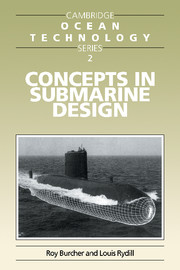Book contents
- Frontmatter
- Contents
- Introduction
- Acknowledgements
- 1 Design in general
- 2 Milestones in submarine history
- 3 Submarine hydrostatics
- 4 The weight/space relationship
- 5 Submarine structures
- 6 Powering of submarines
- 7 Geometric form and arrangements
- 8 Dynamics and control
- 9 Submarine systems
- 10 Considerations of building and costs in design
- 11 Generating a concept design
- Appendix 1 Hydrostatic conditions of flotation
- Appendix 2 Operational practice for keeping in trim
- Appendix 3 Assessing weight and size of variable ballast
- Appendix 4 Submarine pressure hull strength (Prediction of interframe collapse pressures)
- Appendix 5 Estimates of resistance and propulsion
- References and suggested reading
- Index
1 - Design in general
Published online by Cambridge University Press: 05 July 2014
- Frontmatter
- Contents
- Introduction
- Acknowledgements
- 1 Design in general
- 2 Milestones in submarine history
- 3 Submarine hydrostatics
- 4 The weight/space relationship
- 5 Submarine structures
- 6 Powering of submarines
- 7 Geometric form and arrangements
- 8 Dynamics and control
- 9 Submarine systems
- 10 Considerations of building and costs in design
- 11 Generating a concept design
- Appendix 1 Hydrostatic conditions of flotation
- Appendix 2 Operational practice for keeping in trim
- Appendix 3 Assessing weight and size of variable ballast
- Appendix 4 Submarine pressure hull strength (Prediction of interframe collapse pressures)
- Appendix 5 Estimates of resistance and propulsion
- References and suggested reading
- Index
Summary
INTRODUCTION
In this book we attempt to convey an understanding of those aspects of design which are specific to submarines. However, submarine design is just one of many engineering design activities and there are general features which are common to all. Before proceeding to the specific aspects of submarine design, we consider it worthwhile in this first chapter to address the more general aspects and show how they relate to the submarine design task.
DESIGN OBJECTIVES
1.1 Though there are many variations on what may be considered design objectives we suggest that the following three are primary in all designs and should be sustained throughout the whole design process:
(a) that the product should perform the functional purpose of the customer or operator;
(b) that the design should be suitable for construction within the capability of the technology and resources available;
(c) that the cost should be acceptable to the customer.
Though expressed as separate objectives they are interactive and may on occasion be incompatible. The circumstances within which the design takes place may lead to one or another becoming the prime objective with the others subsidiary.
In some situations the performance of the design is paramount: only a design that is capable of fully performing the required function is of interest. In such circumstances the customer would have to be prepared to pay the cost of such a design and even the capital investment to create the technology and resources necessary to realise the design. Some major nations have accepted this situation for defence equipment in the past but it is less prevalent in current political circumstances.
Information
- Type
- Chapter
- Information
- Concepts in Submarine Design , pp. 1 - 10Publisher: Cambridge University PressPrint publication year: 1994
